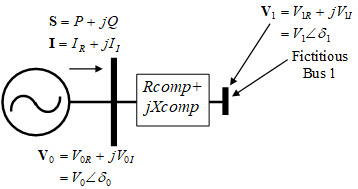Power Flow: Line Drop Compensation
This is a subtopic of the Power Flow Solution Theory Help.
In power system cases, we often model the generator so that it controls a remote bus located somewhere in the rest of the power system (presumably nearby of course). The remote regulation of a bus voltage however may represent a human controlling a bus voltage and not an automatic control system. Imagine the human operator at a generator being instructed to regulate the voltage at the high side of the generator step-up transformer. The operator may be given instruction to keep the voltage at the high side near a particular value. To achieve that they may only have the ability to instruct the exciter of the machine to move the voltage up or down. They may just manually do this until the voltage is close enough. This type of control may take minutes or tens of minutes to respond to an event depending on what other duties the human is responsible for. If you are studying a system response in the few minutes following a sudden event (such as in contingency analysis), it may not be appropriate to assume that the remote voltage regulation is met in the short time frame after the event.
Power system designers understand this limitation and sometimes build in special controls into the voltage regulation (part of the exciter of a generator) that ensure that some remote regulation can be done even without the human interaction and without the need for adding measurements that feed back the voltage at the high side of the transformer to the voltage regulator. Using only local measurements at the terminal of the generator for terminal voltage, power, and current, if we know the impedance between the terminal of the generator at the high side of the transformer we can using complex algebra to get an estimate of the remote voltage using only the local measurements. Generator often regulate a particular percentage of the way through the step-up transformer for instance. This concept is called Line Drop Compensation and is depicted in the following image.

When using line drop compensation, a special equation is used to model the reactive power at the generator terminal bus. The BusCat will be denoted as PQ (Line Drop Comp) in this situation. There are also Switch Shunt Model modes that may result in a PQ (SVC Line Drop Comp) as well.
In PowerWorld Simulator you can configure a generator to use Line Drop Compensation and then specify the Rcomp and Xcomp impedance through which this is done. This is described in the help topic on line drop compensation.